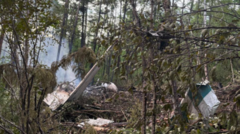On February 3, 2025, salvage operations commenced to lift wreckage from the Potomac River, marking a significant step forward in response to last week's tragic plane crash. The recovery mission aims to uncover more about the incident that claimed the lives of 67 individuals.
Crews Begin Salvage Operation of Plane Crash Wreckage from Potomac

Crews Begin Salvage Operation of Plane Crash Wreckage from Potomac
Recovery teams embark on a three-day mission to retrieve the wreckage of American Airlines Flight 5342 after a collision with a U.S. Army helicopter.
On Monday morning, salvage crews initiated the process to recover parts of American Airlines Flight 5342, which collided with a U.S. Army helicopter in Washington, D.C., resulting in the loss of all on board. Beginning just after 10 a.m. Eastern time, a crane on a barge hoisted what was identified as one of the jet’s engines from the murky waters of the Potomac. The operation is set to last approximately three days, and officials noted that earlier efforts had begun around 8 a.m. to coordinate the recovery efforts.
Col. Francis Pera of the Army Corps of Engineers highlighted that the salvage work aims to recover the remains of remaining victims still unaccounted for after the incident, which occurred during clear weather conditions as the aircraft approached Ronald Reagan National Airport on the evening of January 30. So far, authorities have reported the recovery of 55 victims, while 12 individuals are still missing.
Once lifted from the water, the airplane wreckage will be transported to a hangar for thorough investigation as part of the ongoing inquiry into the accident. As investigators continue their work, concerns have surfaced regarding airport staffing, congestion, and overall safety at what is recognized as one of the country’s busiest airports. While the full scope of the incident is still under investigation, federal authorities have stated that it is premature to offer specific insights into the cause of the crash, which stands as the worst aviation disaster in the United States in two decades.
Col. Francis Pera of the Army Corps of Engineers highlighted that the salvage work aims to recover the remains of remaining victims still unaccounted for after the incident, which occurred during clear weather conditions as the aircraft approached Ronald Reagan National Airport on the evening of January 30. So far, authorities have reported the recovery of 55 victims, while 12 individuals are still missing.
Once lifted from the water, the airplane wreckage will be transported to a hangar for thorough investigation as part of the ongoing inquiry into the accident. As investigators continue their work, concerns have surfaced regarding airport staffing, congestion, and overall safety at what is recognized as one of the country’s busiest airports. While the full scope of the incident is still under investigation, federal authorities have stated that it is premature to offer specific insights into the cause of the crash, which stands as the worst aviation disaster in the United States in two decades.




















